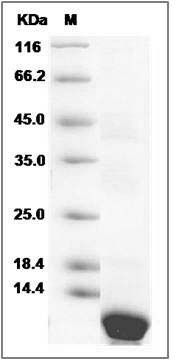-
Product Name
Human Pepsinogen C/PGC (His Tag) recombinant protein
- Documents
-
Description
Pepsinogen C, also known as PGC, is an aspartic proteinase that belongs to the peptidase family A1. Pepsinogen C is synthesized in the gastric mucosa as inactive precursors, known as zymogens. Pepsinogen C contains a prosegment that serves to stabilize the inactive form and prevent entry of the substrate to the active site. At low PH conditions, Pepsinogen C undergoes conversion into active enzyme. Pepsinogen C has been found expressed in all regions of the stomach mucosa and also in the proximal duodenal mucosa. In stomach cancer tissues and cancer cell lines, the expressions of the pepsinogen genes were decreased or lost, in good accordance with their pepsinogen productions. No gross structural changes of the pepsinogen genes were observed in these cancers, but the methylation patterns of the pepsinogen genes were found to be altered in different ways in different cancers. Serum levels of Pepsinogen C are used as a biomarker for certain gastric diseases including Helicobacter pylori related gastritis.
-
Protein name
Gastricsin
-
Protein short names
2210410L06RIK; FLJ99563; UPG-1; PG-1; PEPSINOGEN C; UPG1; PGII; PROGASTRICSIN; PG1; URINARY PEPSINOGEN 1; PEPSIN C; GASTRICSIN; PEPSINOGEN GROUP II; MGC117575; RP11-298J23.1; PGC; PREPROGASTRICSIN; PEPC
-
Uniprot ID
P20142
-
Gene Name
PGC
-
Source/Expression Host
E. coli
-
Expression Plasmid/cDNA
A DNA sequence encoding the mature form of human PGC (P20142-1) (Ile153-Ile239) was expressed with a polyhistide tag at the N-terminus.
-
Protein Species
Human
-
Molecular weight
The recombinant human PGC consists of 102 amino acids and predicts a molecular mass of 10.9 KDa. It migrates as an approximately 10 KDa band in SDS-PAGE under reducing conditions.
-
Purity
> 95 % as determined by SDS-PAGE
-
Validations

Human Pepsinogen C / PGC Protein (His Tag) SDS-PAGE
Related Products / Services
Please note: All products are "FOR RESEARCH USE ONLY AND ARE NOT INTENDED FOR DIAGNOSTIC OR THERAPEUTIC USE"
